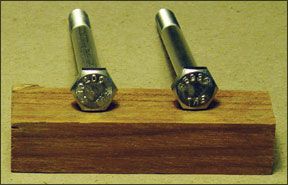I am re-mounting the handrails and deck hardware on our 26-year-old Tartan 33. I had detected some moisture around the mounting area on the handrails and decided to remove them, and fill and re-drill them with epoxy.
To my surprise and dismay, I found a lot of crevice corrosion on the existing bolts, and at least three of the heads broke off

Photo courtesy of Bob Weismantel
288
when I removed the rails.
I recently purchased a quantity of 1/4-20 x 3-inch bolts from two marine stores to replace the old ones. Both sets were supposed to be 18-8 stainless. However, when I put a magnet on them, there appears to be an attraction, which indicates to me that there is some ferrous material in them. One set is marked S30400-THE, and the other set is marked F593C-THE.
Should I use them?
Bob Weismantel
Tartan 33
Via e-mail
Both bolts appear to be 18-8 bolts; more specifically, they are made of 304 stainless steel. Unfortunately 304 is a lower grade than 316, which is what we’d recommend for this application. The markings “THE” indicate that they originated from Tong Hwei Enterprises, a huge supplier in Taiwan.
Grade 304 bolts may exhibit magnetic properties as a result of fabrication, which is normal. They are a good compromise between strength and corrosion resistance for many marine applications.
They are not as resistant as 316-grade steel to crevice corrosion (also called chloride stress corrosion), which occurs when stainless steel is deprived of oxygen. This can happen when fasteners are bedded in wet wood or wet fiberglass, as was the case with the existing bolts in your handrails. The more expensive 316-grade stainless will mean better corrosion resistance, but it also means less tensile strength and less resistance to brittle metal failure caused by work hardening.
For more frequent load-bearing applications, the bolt stamped “F593C” would be preferred. The stamp means it meets parameters set by the American Society for Testing and Materials International (www.astm.org). These bolts generally have a tensile strength that is roughly 20-percent greater than the usual 18-8 fastener.
It’s not an issue with the bolts you purchased, but be aware that hash marks on the head of a stainless fastener are not indications of its tensile strength as they are on mild-steel fasteners. Hash marks on stainless heads simply mean that the bolt is 18-8 alloy.
In addition to crevice corrosion, another common problem with stainless fasteners is pitting corrosion. To reduce the chances of pitting, stainless nuts and bolts should be polished. Smoothing out the porous exterior will enhance their corrosion resistance.
Be wary of changing to stainless for some key applications, particularly in the drive train of your engine as stainless is not as suitable for these jobs, which require higher strength and resistance to work hardening.
When bedding bolts, be sure to clean them well with an emulsifying agent. Most fasteners—even new ones—are contaminated with oils, grease, or waxes. Washing them with acetone or denatured alcohol will help ensure proper bedding. If fastening to aluminum, a coating of TefGel (www.tefgel.com) or Duralac (www.hallspars.com) will help isolate and protect the aluminum.
For more information, check out the Marine Fasteners website: www.marfas.com. Marine Fasteners, a large supplier, also can answer more specific questions regarding materials and tensile strengths.

































